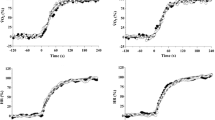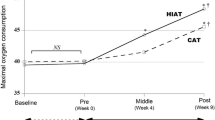Abstract
Purpose
The aim of the present study was to compare the energy expenditure (EE) during and after two treadmill protocols, high-intensity interval training (HIIT) and moderate continuous training (CONT), in young adult men.
Methods
The sample was comprised by 26 physically active men aged between 18 and 35 years engaged in aerobic training programs. They were divided into two groups: HIIT (n = 14) which performed eight 20 s bouts at 130% of the velocity associated with the maximal oxygen consumption on a treadmill with 10 s of passive rest, or CONT (n = 12) which performed 30 min running on a treadmill at a submaximal velocity equivalent to 90–95% of the heart rate associated with the anaerobic threshold. Data related to oxygen consumption (\(\dot{V}{\text{O}}_{2}\)) and EE were measured during the protocols and the excess post-exercise oxygen consumption (EPOC) was calculated for both sessions.
Results
No difference was found between groups for mean \(\dot{V}{\text{O}}_{2}\) (HIIT: 2.84 ± 0.46 L min−1; CONT: 2.72 ± 0.43 L min−1) and EE per minute (HIIT: 14.36 ± 2.34 kcal min−1; CONT: 13.21 ± 2.08 kcal min−1) during protocols. Regarding total EE during session, CONT resulted in higher values compared to HIIT (390.45 ± 65.15; 55.20 ± 9.33 kcal, respectively). However, post-exercise EE and EPOC values were higher after HIIT (69.31 ± 10.88; 26.27 ± 2.28 kcal, respectively) compared to CONT (55.99 ± 10.20; 13.43 ± 10.45 kcal, respectively).
Conclusion
These data suggest that supramaximal HIIT has a higher impact on EE and EPOC in the early phase of recovery when compared to CONT.


Similar content being viewed by others
Abbreviations
- ANOVA:
-
Analysis of variance
- CE:
-
Caloric equivalent
- CONT:
-
Moderate-intensity continuous training
- EE:
-
Energy expenditure
- EPOC:
-
Excess post-exercise oxygen consumption
- HIIT:
-
High-intensity interval training
- HR:
-
Heart rate
- HRmax :
-
Maximal heart rate
- \({\text{i}}\dot{V}{\text{O}}_{2\hbox{max} }\) :
-
Intensity associated with maximal oxygen consumption
- \(\dot{V}{\text{O}}_{2}\) :
-
Maximal oxygen consumption
- VT2 :
-
Second ventilatory threshold
References
Alberton CL, Pinto SS, Antunes AH, Cadore EL, Finatto P, Tartaruga MP, Kruel LF (2014) Maximal and ventilatory thresholds cardiorespiratory responses to three water aerobic exercises compared with treadmill on land. J Strength Cond Res 28:1679–1687. doi:10.1519/JSC.0000000000000304
Bahr R, Gronnerod O, Sejersted OM (1992) Effect of supramaximal exercise on excess postexercise O2 consumption. Med Sci Sports Exerc 24:66–71
Borsheim E, Bahr R (2003) Effect of exercise intensity, duration and mode on post-exercise oxygen consumption. Sports Med 33:1037–1060. doi:10.2165/00007256-200333140-00002
Buchheit M, Laursen PB (2013) High-intensity interval training, solutions to the programming puzzle: part I: cardiopulmonary emphasis. Sports Med 43:313–338. doi:10.1007/s40279-013-0029-x
Cunha FA, Midgley AW, McNaughton LR, Farinatti PT (2016) Effect of continuous and intermittent bouts of isocaloric cycling and running exercise on excess postexercise oxygen consumption. J Sci Med Sport 19:187–192. doi:10.1016/j.jsams.2015.02.004
Dawson B, Straton S, Randall N (1996) Oxygen consumption during recovery from prolonged submaximal cycling below the anaerobic threshold. J Sports Med Phys Fit 36:77–84
Ferreti G (2014) Maximal oxygen consumption in healthy humans: theories and facts. Eur J Appl Physiol 114:2007–2036. doi:10.1007/s00421-014-2911-0
Frey GC, Byrnes WC, Mazzeo RS (1993) Factors influencing excess postexercise oxygen consumption in trained and untrained women. Metabolism 42:822–828. doi:10.1016/0026-0495(93)90053-Q
Friedman RA, Navalta JW, Fedor EA, Kell HB, Lyons TS, Arnett SW, Schafer MA (2012) Repeated high-intensity Wingate cycle bouts influence markers of lymphocyte migration but not apoptosis. Appl Physiol Nutr Metab 37:241–246. doi:10.1139/h11-156
Gaesser GA, Brooks GA (1984) Metabolic bases of excess post-exercise oxygen consumption: a review. Med Sci Sports Exerc 16:29–43. doi:10.1249/00005768-198401000-00008
Gore CJ, Withers RT (1990) The effect of exercise intensity and duration on the oxygen deficit and excess post-exercise oxygen consumption. Eur J Appl Physiol 60:169–174. doi:10.1007/BF00713508
Greer BK, Sirithienthad P, Moffatt RJ, Marcello RT, Panton LB (2015) EPOC comparison between isocaloric bouts of steady-state aerobic, intermittent aerobic, and resistance training. Res Q Exerc Sport 86:190–195. doi:10.1080/02701367.2014.999190
Hagberg JM, Mullin JP, Nagle FJ (1980) Effect of work intensity and duration on recovery O2. J Appl Physiol Respir Environ Exerc Physiol 48:540–544
Hazell TJ, Olver TD, Hamilton CD, Lemon PW (2012) Two minutes of sprint-interval exercise elicits 24-hr oxygen consumption similar to that of 30 min of continuous endurance exercise. Int J Sport Nutr Exerc Metab 22:276–283. doi:10.1123/ijsnem.22.4.276
Howley ET, Bassett DR Jr, Welch HG (1995) Criteria for maximal oxygen uptake: review and commentary. Med Sci Sports Exerc 27:1292–1301
Jackson AS, Pollock ML (1978) Generalized equations for predicting body density of men. Br J Nutr 40:497–504
Jacobsen DJ, Bailey BW, LeCheminant JD, Hill JO, Mayo MS, Donnelly JE (2005) A comparison of three methods of analyzing post-exercise oxygen consumption. Int J Sports Med 26(1):34–38. doi:10.1055/s-2004-815819
LaForgia J, Withers RT, Shipp NJ, Gore CJ (1997) Comparison of energy expenditure elevations after submaximal and supramaximal running. J Appl Physiol 82:661–666
LaForgia J, Withers RT, Gore CJ (2006) Effects of exercise intensity and duration on the excess post-exercise oxygen consumption. J Sports Sci 24:1247–1264. doi:10.1080/02640410600552064
Larsen I, Welde B, Martins C, Tjonna AE (2014) High- and moderate-intensity aerobic exercise and excess post-exercise oxygen consumption in men with metabolic syndrome. Scand J Med Sci Sports 24:e174–e179. doi:10.1111/sms.12132
Malatesta D, Werlen C, Bulfaro S, Cheneviere X, Borrani F (2009) Effect of high-intensity interval exercise on lipid oxidation during postexercise recovery. Med Sci Sports Exerc 41:364–374. doi:10.1249/MSS.0b013e3181857edo
Matsuo T, Ohkawara K, Seino S, Shimojo N, Yamada S, Ohshima H, Tanaka K, Mukai C (2012a) Cardiorespiratory fitness level correlates inversely with excess post-exercise oxygen consumption after aerobic-type interval training. BMC Res Notes 5:646. doi:10.1186/1756-0500-5-646
Matsuo T, Ohkawara K, Seino S, Shimojo N, Yamada S, Ohshima H, Tanaka K, Mukai C (2012b) An exercise protocol designed to control energy expenditure for long-term space missions. Aviat Space Environ Med 83:783–789. doi:10.3357/ASEM.3298.2012
McGarvey W, Jones R, Petersen S (2005) Excess post-exercise oxygen consumption following continuous and interval cycling exercise. Int J Sport Nutr Exerc Metab 15:28–37. doi:10.1123/ijsnem.15.1.28
Metcalfe RS, Koumanov F, Ruffino JS, Stokes KA, Holman GD, Thompson D, Vollaard NB (2015) Physiological and molecular responses to an acute bout of reduced-exertion high-intensity interval training (REHIT). Eur J Appl Physiol 115:2321–2334. doi:10.1007/s00421-015-3217-6
Muniz-Pumares D, Pedlar C, Godfrey RJ, Glaister M (2016) Accumulated oxygen deficit during exercise to exhaustion determined at different supramaximal work-rates. Int J Sports Physiol Perform 24:1–17. doi:10.1123/ijspp.2015-0343
Olmedo AC (2011) Post-exercise oxygen consumption after continuous and interval exercise on a treadmill. Apunts Educación Física y Deportes 104:21–27. doi:10.5672/apunts.2014-0983.es(2011/2).104.02
Poole DC, Jones AM (2012) Oxygen uptake kinetics. Compr Physiol 2:933–996. doi:10.1002/cphy.c100072
Reinhard U, Muller PH, Schmulling RM (1979) Determination of anaerobic threshold by the ventilation equivalent in normal individuals. Respiration 38(1):36–42. doi:10.1159/000194056
Siri WE (1993) Body composition from fluid spaces and density: analysis of methods. Nutrition 9:480–491
Skelly LE, Andrews PC, Gillen JB, Martin BJ, Percival ME, Gibala MJ (2014) High-intensity interval exercise induces 24-h energy expenditure similar to traditional endurance exercise despite reduced time commitment. Appl Physiol Nutr Metab 39:845–848. doi:10.1139/apnm-2013-0562
Smith J, Mc Naughton L (1993) The effects of intensity of exercise on excess postexercise oxygen consumption and energy expenditure in moderately trained men and women. Eur J Appl Physiol Occup Physiol 67:420–425. doi:10.1007/BF00376458
Townsend JR et al (2013) Excess post-exercise oxygen consumption (EPOC) following multiple effort sprint and moderate aerobic exercise. Kinesiology 45:16–21
Tschakert G, Hofmann P (2013) High-intensity intermittent exercise: methodological and physiological aspects. Int J Sports Physiol Perform 8:600–610
Wasserman K, Whipp BJ, Koyl SN, Beaver WL (1973) Anaerobic threshold and respiratory gas exchange during exercise. J Appl Physiol 35:236–243
Williams CB, Zelt JG, Castellani LN, Little JP, Jung ME, Wright DC, Tschakovsky ME, Gurd BJ (2013) Changes in mechanisms proposed to mediate fat loss following an acute bout of high-intensity interval and endurance exercise. Appl Physiol Nutr Metab 38:1236–1244. doi:10.1139/apnm-2013-0101
Wilmore JH, Parr RB, Ward P, Volak PA, Barstow TJ, Pipes TV, Grimditch G, Leslie P (1978) Energy cost of circuit weight training. Med Sci Sport Exerc 10:75–78
Wolpern AE, Burgos DJ, Janot JM, Dalleck LC (2015) Is a threshold-based model a superior method to the relative percent concept for establishing individual exercise intensity? a randomized controlled trial. BMC Sports Sci Med Rehabil 7:16. doi:10.1186/s13102-015-0011-z
Acknowledgements
The authors would like to thank all subjects who took part in the study for their genuine effort.
Author information
Authors and Affiliations
Corresponding author
Ethics declarations
Conflict of interest
The authors attest that they have no conflict of interest.
Ethical approval
All procedures performed in studies involving human participants were in accordance with the ethical standards of the institutional and/or national research committee and with the 1964 Helsinki declaration and its later amendments or comparable ethical standards.
Informed consent
Informed consent was obtained from all individual participants included in the study.
Additional information
Communicated by Guido Ferretti.
Rights and permissions
About this article
Cite this article
Schaun, G.Z., Alberton, C.L., Ribeiro, D.O. et al. Acute effects of high-intensity interval training and moderate-intensity continuous training sessions on cardiorespiratory parameters in healthy young men. Eur J Appl Physiol 117, 1437–1444 (2017). https://doi.org/10.1007/s00421-017-3636-7
Received:
Accepted:
Published:
Issue Date:
DOI: https://doi.org/10.1007/s00421-017-3636-7




